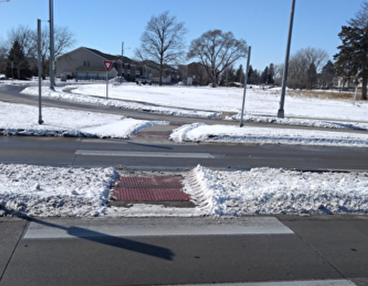
Pedestrian fatalities make up almost 14 percent of traffic fatalities in Minnesota—yet we all know that winter takes up more than 14 percent of our calendar. Still, there’s little research that explicitly considers the year-round maintenance needs of pedestrian safety countermeasures such as median islands.
A MnDOT-funded project helps fill the gap. The project identified best practices for designing pedestrian safety countermeasures that not only reduce the risks of crashes and other incidents but also are compatible with effective winter maintenance operations.
Keeping walkways, curb ramps, median refuge islands, and other features safe requires keeping them free from snow and ice. Snowplows, however, may have difficulty navigating around them, and snow may pile up in these areas. Agencies may need additional equipment to clear walkways and other areas.
The study included interviews with maintenance professionals from Minnesota local agencies and best practice case studies of strategies used by four jurisdictions in Minnesota, Wisconsin, and Manitoba.
The primary conclusion of the research team, led by David Veneziano of Iowa State University, confirmed a lack of policies or documentation for designs that facilitate year-round maintenance. Winter maintenance practices for pedestrian treatments tend to vary by jurisdiction.
What policies and plans there are largely concentrate on sidewalks and who will conduct winter maintenance (i.e., property owners vs. governments) and the timeline in which it should be completed, as opposed to discussing designs that can encourage or ease that maintenance. Clearing curb ramps and sidewalks, for example, is usually the responsibility of the adjacent property owner. Responsibility for areas like median refuge islands and other walkways, however, is often ambiguous.
Based on lessons learned from other agencies, researchers developed numerous recommendations, including:
- Discuss design plans for pedestrian safety features with maintenance personnel early in the process.
- Incorporate dedicated snow storage locations and hauling capacity into the design, if needed.
- Carefully consider the durability of decorative or other features used for visual appeal.
- Ensure sufficient maintenance staff resources and establish hierarchies of snow and ice removal priorities for pedestrian facilities.
- Clarify and codify responsibilities and time frames for winter maintenance of pedestrian safety features.
Additionally, researchers provided design recommendations for each of the seven safety treatments identified. For example, certain sizes, dimensions, and shapes make pedestrian features such as curb extensions, median islands, and speed humps more effective and maintainable.
Last, researchers presented trade-offs between safety and maintainability for each safety feature design, including safety benefits, winter maintenance costs, and general costs.
Learn more:
- Designing and Implementing Maintainable Pedestrian Safety Countermeasures (LRRB/MnDOT, Apr. 2023)